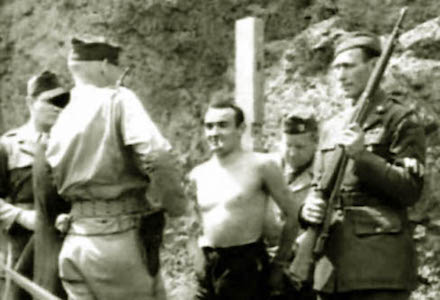(Thanks to Meaghan Good of the Charley Project for the guest post. -ed.)
The story of what would become known as the Wright County War began on September 21, 1858, when Henry A. Wallace was found lying dead in a clump of willows on his own farm, his head bashed in. He had last been seen alive on August 27, twenty-five days earlier.
Wallace’s employee, Oscar F. Jackson, was the prime suspect in his murder. Jackson had agreed to help Wallace reap his hay crop in exchange for a portion of the harvest, and on August 27 the two men had been seen working together in the fields near where Wallace’s body was later found.
Jackson showed a curious lack of concern about his boss’s disappearance. He never even bothered to tell the authorities he was missing, and when neighbors noted that Wallace hadn’t been seen in weeks and decided to launch a search, Jackson declined to join in. An impoverished sharecropper, Jackson also seemed to have become suddenly flush with cash — an oddity because like most of the residents of Wright County, Jackson was poor, still struggling to recover from the Panic of 1857. Wallace was comparatively well-off.
A grand jury indicted Jackson for his employer’s murder, but the case against him was incredibly feeble. At the trial, Jackson’s attorneys pointed out that no one had seen the murder or could even determine the day it took place, and suggested any number of people could have visited Wallace and killed him at any time during that three-and-a-half-week period that he was missing.
The jury quite rightly gave Jackson the benefit of doubt and acquitted him on April 3, 1859, after eighteen hours of deliberation.
That night, a lynch party of fifteen men chased him into the woods. Fearing for his life, Jackson fled to St. Paul.
The local citizenry — among them Henry Wallace’s brother, Hiram — were not prepared to let the matter rest. And, horrifyingly, neither was the Wright County Sheriff, George M. Bertram,* or the justice of the peace, Cyrus Chase Jenks.
Five days after Jackson’s acquittal, the three men went to find the presumed murderer in Hennepin County. There, Hiram Wallace swore out a complaint against Jackson accusing him of theft, and Jenks issued a warrant for his arrest. Never mind that Jenks did not have jurisdiction outside of Wright County: Sheriff Bertram delivered the warrant to Alfred Brackett, the deputy sheriff of Hennepin County, and asked him to serve it.
Walter N. Trenery wrote in his 1962 book, Murder in Minnesota,
Brackett found Jackson in St. Paul’s Apollo Saloon the next day. Handcuffing his prisoner, the deputy set out with him for St. Anthony by buggy. Jackson pleaded for time to call his attorney, but at first Brackett would not allow it. On the ride Jackson insisted that his arrest was based on a false charge, the purpose of which was to get him back to Rockford [in Wright County] where he would be murdered… Brackett reconsidered. When the two men reached St. Anthony, he sent word to Jackson’s counsel and persuaded the Wright County sheriff to spend the night in town before starting back to Rockford.

The implacable Sheriff Bertram
Jackson’s lawyer hastily drew up a writ of habeas corpus and before the day was out he’d served it to Sheriff Bertram. The Hon. Isaac Atwater, a Minnesota Supreme Court justice, ordered Jackson’s release on April 11. He was immediately re-arrested, however, as by then Jenks and Bertram had realized their error, gone back to Wright County and drawn up a second warrant. Jackson’s attorney responded with a second writ of habeas corpus, and on April 13, the man was ordered released again.
His friends had pooled their money and come up with enough for him to leave Minnesota forever, but for some reason Jackson returned to Rockford instead of skipping town. The residents of Wright County still wanted to lynch him, and to that end a neighbor swore out yet another phony complaint against him and yet another justice of the peace issued yet another warrant for his arrest.
A mob virtually tore Jackson’s cabin and its contents to pieces and set several fires. They surrounded the home of Jackson’s father-in-law, George Holdship, where the fugitive was reported to be hiding, and set more fires.
On April 24, Sheriff Bertram arrived at Holdship’s residence, and after he swore Jackson would not be harmed, arrested Jackson and took him away.
According to John D. Bessler’s book Legacy Of Violence: Lynch Mobs And Executions In Minnesota,
Less than half a mile from the house an armed mob overtook Sheriff Bertram’s procession. The sheriff relinquished power without resistance and rode off with the deputies, failing to even report the incident. After taunting Jackson throughout the night, the mob strung him up, even as his wife arrived to plead for mercy. Her pleas ignored, she was sent away distraught and empty-handed. The bloodthirsty mob hauled Jackson up and down times, failing to get Jackson to confess but successfully mangling his neck. Only when Jackson was hoisted up for a third time, at 2:00 P.M. on April 25, did his neck break. Jackson’s body was left dangling from a beam that protruded from Wallace’s cabin.
A coroner’s jury was called on the same day Jackson died and decided he had met with his death at the hands of some person or persons unknown. “The jury was not likely,” Trenery noted dryly, “to accuse its own members.”
But the story didn’t end there.
At the time of Oscar Jackson’s lynching, Minnesota had been a state for less than a year; it was admitted to the Union on May 11, 1858. Their first state governor, Henry Hastings Sibley, was anxious to maintain the rule of law, which had been besmirched by the Jackson outrage. One newspaper said, a tad melodramatically, “Wright County will be painted black upon the map of Minnesota — a patch of loathsome leprosy upon the fair surface of the land.”
Sibley offered a $500 reward for the arrest and conviction of anyone concerned with the lynching. It went unclaimed and the lynching started to slip away into obscurity, until July, when Oscar Jackson’s wife spotted Emery W. Moore (called “Emory” or “Aymer” in some accounts) at a gathering in Minnehaha Falls. Moore had been a member of the lynch mob, and it was his warrant that lead to Jackson’s arrest at his father-in-law’s house.
Mrs. Jackson alerted St. Paul’s chief of police, who arrested Moore for murder, and he was sent to Rockford to stand trial.
What followed, as Trenery describes it, was something of a solemn farce:
To prevent further collusion among local officials, the governor directed Charles H. Berry, the state’s attorney general, to conduct the prosecution in person. Berry opened the preliminary examination in Monticello on July 31, 1859, with an angry mob swarming about the building, shouting and threatening the agents of law enforcement. Mrs. Jackson, testifying for the prosecution, clearly and unequivocally named the leaders of the lynch mob and described the circumstances under which her husband had died. When the Wright County sheriff took the stand to explain how the mob had overwhelmed him and took Jackson from his custody, the attorney general found the sheriff’s explanation so unsatisfactory that he ordered Bertram arrested and held as an accomplice in the lynching. Berry then discovered that certain prosecution witnesses had mysteriously disappeared before they could testify, and he was forced to adjourn the hearing before it had been in session a full day.
To add insult to injury, that evening the vigilantes descended on the place where Emery Moore was confined, set him free, and melted into the darkness.
Berry returned to St. Paul and reported all this to the governor.
Fed up, Sibley declared Wright County to be “in a state of insurrection” and sent in the state militia to put a stop to mob justice and force the county officials to do their damn jobs. Three units — the Pioneer Guards, the St. Paul City Guards and the Stillwater Guards — marched in, aided by 35 special policemen.
The results were mixed. At first the militia was unable to find any members of the lynch mob, the locals just shrugged their shoulders when asked where they had gone, and the sheriff and other officials refused outright to cooperate. Only when they found out Governor Sibley was on his way over to personally take charge did the county officials “find” and arrest three suspected lynchers: Emery Moore, Hiram S. Angell, and J.E. Jenks.**
Satisfied, the governor sent the state militia home. The three-day occupation was later facetiously dubbed the Wright County War. It was a bloodless war.
The arrested men were almost immediately set free on a $500 bail, and in October, a grand jury refused to indict them. In the end, no one at all was punished for Oscar Jackson’s death, and Henry Wallace’s murder was never officially solved.
Charles Bryant groused in his History of the Upper Mississippi Valley,
And so the drama ended; the curtain fell; and the so-called “Wright county war” was a thing of the past. Its effects, however, long remained in the enormous expense incurred, which, with other criminal cases of less magnitude, created an indebtedness almost resulting in bankruptcy, and depreciating county orders to less than thirty-five cents on the dollar.
Of the principals involved in this story:
- Sheriff Bertram left office in 1860 and was succeeded by W. Smith Brookins.
- Cyrus Jenks died in Meeker City, Minnesota in 1897. He was almost 90 years old.
- Governor Sibley stayed in office until 1860, and did not seek reelection. In 1862, he was appointed colonel of the Minnesota Militia and led them against the Native Americans in the Dakota War.
- Charles Berry was later appointed as a judge in the Idaho Territory. He died in 1900.
- Alfred Brackett fought in the Civil War, leading what would become Brackett’s Battallion, which served longer than any other Minnesota unit. The unit fought against the Confederates between 1861 and 1864, then became part of the Northwestern Indian Expedition in the Dakota Territory.
- Hiram Angell also fought in the Civil War, with the Third Minnesota Volunteer Infantry Regiment. He died in St. Louis, Kentucky on April 5, 1862.
- J.E. Jenks got elected to Minnesota’s House of Representatives in the 1870s and served for a year.
Nearly twenty years after Henry Wallace’s death, first his gold watch and then his rifle were found near the former site of Oscar Jackson’s cabin.
* Wright County boasts a Bertram Chain of Lakes, named for Sheriff Bertram.
** J.E. Jenks was probably Cyrus Jenks’s son; records note that Cyrus had a son named John Edwin Jenks who would have been about 22 years old in 1859, which matches J.E.’s first name and age.
On this day..










 We can only really be sure of the one murder: on September 1, 1894, he attacked 56-year-old Julianna Hoffman in her room on East Sixth Street, for the possible reason of robbing her. One ferocious slash with his long bread knife nearly decapitated the landlady; the disturbance roused Hoffman’s 16-year-old son who burst in on the assailant — reportedly just as Feigenbaum had his blade poised to begin horribly gouging the corpse. Both killer and witness grappled briefly and then fled from each other; Feigenbaum was arrested before the day was out.
We can only really be sure of the one murder: on September 1, 1894, he attacked 56-year-old Julianna Hoffman in her room on East Sixth Street, for the possible reason of robbing her. One ferocious slash with his long bread knife nearly decapitated the landlady; the disturbance roused Hoffman’s 16-year-old son who burst in on the assailant — reportedly just as Feigenbaum had his blade poised to begin horribly gouging the corpse. Both killer and witness grappled briefly and then fled from each other; Feigenbaum was arrested before the day was out.







